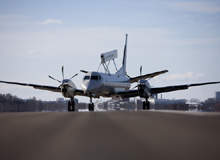- Copy to clipboard
- Moderator
- #1
- Jan 25, 2024
- 111,139
- 831
- Origin

- Residence

An airborne early warning and control (AEW&C) system is an airborne radar system designed to detect aircraft, ships, vehicles, missiles, and other incoming projectiles at long ranges and perform command and control of the battlespace in an air engagement by directing fighter and attack aircraft strikes. AEW&C units are also used to carry out surveillance, including over ground targets and frequently perform battle management command and control (BMC2). When used at altitude, the radar on the aircraft allows the operators to detect and track targets and distinguish between friendly and hostile aircraft much farther away than a similar ground-based radar.[1] Like a ground-based radar, it can be detected by opposing forces, but because of its mobility and extended sensor range, it is much less vulnerable to counter-attacks.
AEW&C aircraft are used for both defensive and offensive air operations, and are to NATO and US-trained or integrated air forces what the combat information center is to a naval warship, in addition to being a highly mobile and powerful radar platform. The system is used offensively to direct fighters to their target locations, and defensively, directing counterattacks on enemy forces, both air and ground. So useful is the advantage of command and control aircraft operating at a high altitude, that some navies operate such aircraft from their warships at sea.
In the case of US Navy, the Northrop Grumman E-2 Hawkeye AEW&C aircraft is assigned to its supercarriers to protect them and augment their onboard command information centers (CICs). The designation "airborne early warning" (AEW) was used for earlier similar aircraft used in the less-demanding radar picket role, such as the Fairey Gannet AEW.3 and Lockheed EC-121 Warning Star, and continues to be used by the RAF for its Sentry AEW1, while AEW&C (airborne early warning and control) emphasizes the command and control capabilities that may not be present on smaller or simpler radar picket aircraft. AWACS (Airborne Warning and Control System) is the name of the specific system installed in the E-3 and Japanese Boeing E-767 AEW&C airframes, but is often used as a general synonym for AEW&C.
AEW&C aircraft are used for both defensive and offensive air operations, and are to NATO and US-trained or integrated air forces what the combat information center is to a naval warship, in addition to being a highly mobile and powerful radar platform. The system is used offensively to direct fighters to their target locations, and defensively, directing counterattacks on enemy forces, both air and ground. So useful is the advantage of command and control aircraft operating at a high altitude, that some navies operate such aircraft from their warships at sea.
In the case of US Navy, the Northrop Grumman E-2 Hawkeye AEW&C aircraft is assigned to its supercarriers to protect them and augment their onboard command information centers (CICs). The designation "airborne early warning" (AEW) was used for earlier similar aircraft used in the less-demanding radar picket role, such as the Fairey Gannet AEW.3 and Lockheed EC-121 Warning Star, and continues to be used by the RAF for its Sentry AEW1, while AEW&C (airborne early warning and control) emphasizes the command and control capabilities that may not be present on smaller or simpler radar picket aircraft. AWACS (Airborne Warning and Control System) is the name of the specific system installed in the E-3 and Japanese Boeing E-767 AEW&C airframes, but is often used as a general synonym for AEW&C.

